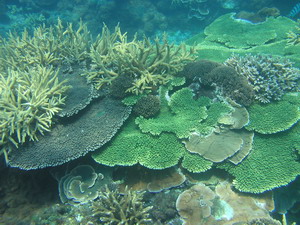 來自72個國家的代表12日在印尼馬納都(Manado)舉行海岸與海洋資源會議,預計將在15日作出計畫決議,以保育史上最大的海洋生態保護區,「珊瑚大三角計畫」(Coral Triangle Initiative)。
來自72個國家的代表12日在印尼馬納都(Manado)舉行海岸與海洋資源會議,預計將在15日作出計畫決議,以保育史上最大的海洋生態保護區,「珊瑚大三角計畫」(Coral Triangle Initiative)。
自北方的菲律賓至南邊的印尼,「珊瑚大三角」蘊藏世界密度最高的海洋生物,超過600種造礁珊瑚,與擁有重要商業價值的最大鮪魚族群-全球50%的鮪魚產於此。
該區域的面積廣達230萬平方英里(約570萬平方公里),有3000種以上種珊瑚礁魚棲息於此。超過1億5000萬以上的人口居住在「珊瑚大三角」內,估計有225萬的漁民仰賴其中的海洋資源維生。石灰岩礁、海草原與沿岸紅樹林,吸引了海龜、座頭鯨到此休息、覓食與繁殖。
為了保護容易受全球暖化影響衝擊的珊瑚生態,與「珊瑚大三角」相毗鄰的六國國家,印尼、馬來西亞、巴布亞新幾內亞、菲律賓、索羅門群島與東帝汶,其外交部長本周到馬納都,進行首次的珊瑚高峰會。六國首長期望在15日達成協議,通過一項區域性行動計畫,該計畫將作為六國合作推動海岸與海洋資源永續管理的藍圖。
在此之前,六國早已同意建立一套機制對抗珊瑚白化,在美國國家海洋暨大氣總署(NOAA)衛星監督的協助下,設立「珊瑚白化警戒網路」(Coral Bleaching Alert Network)。
澳洲研究委員會珊瑚礁研究卓越中心(Centre of Excellence for Coral Reef Studies)主任泰瑞(Terry Hughes)12日在瑪納都的會議上表示:「珊瑚大三角計畫是世界史上最重要的海洋保育計畫之一,也是第一個跨國計畫。」泰瑞表示:「珊瑚保育的重要性等同於國家建設與糧食安全。」
專家警告,若不立即採取措施保護珊瑚礁,珊瑚礁資源將在2050年耗竭。
澳洲大堡礁海洋公園署由麥庫克博士(Laurence McCook)所領導的團隊建議,拯救受威脅珊瑚生態系統的關鍵在維持珊瑚礁之間的連結關係,讓珊瑚蟲在之間流動並且再次進駐白化、耗竭的區域。
Thousands of delegates from 72 countries have gathered in Manado for a conference on coastal and marine resources that will conclude Friday with a plan of action to safeguard the largest marine reserve in history, the Coral Triangle Initiative.
From the Philippines in the north to Indonesia in the south, the Coral Triangle supports the world's greatest density of marine life, more than 600 species of reef-building corals and the world's largest population of commercially important tuna species, supplying 50 percent of global tuna production.
This ocean expanse covers an area of 2.3 million square miles (5.7 million km2). It is inhabited by more than 3,000 species of reef fish. Over 150 million people live within the Coral Triangle, of which an estimated 2.25 million fishers are dependant on marine resources for their livelihoods.
Limestone reefs, sea grass meadows and coastal mangrove forests attract sea turtles and humpback whales to feed, breed and rest.
To protect this vulnerable area from the impacts of global warming, foreign affairs ministers from the six countries bordering the Coral Triangle - Indonesia, Malaysia, Papua New Guinea, the Philippines, the Solomon Islands and Timor Leste - are in Manado for the first coral summit, with sessions all this week.
On Friday, the six heads of state are expected to adopt a regional plan of action that will serve as a blueprint for their cooperation on sustainable management of coastal and marine resources.
The six countries already have agreed to set up a mechanism to combat coral bleaching and establish a Coral Bleaching Alert Network supported by satellite surveillance by the U.S. National Oceanic and Atmospheric Administration.
"The Coral Triangle Initiative is one of the most important marine conservation measures ever undertaken anywhere in the world and the first to span several countries," said Professor Terry Hughes, director of Australian Research Council's Centre of Excellence for Coral Reef Studies, who is at the Coral Triangle meeting today in Manado.
"It is as much about nation building and food security as it is about reef conservation," he said.
Experts have warned that the world's coral reefs may be depleted by 2050 if no immediate action is taken to protect them.
The key to saving threatened coral ecosystems is to maintain connective links between reefs allowing larvae to flow between them and re-stock depleted areas, advises the team led by Pew Fellow Dr. Laurence McCook of Australia's Great Barrier Reef Marine Park Authority.


